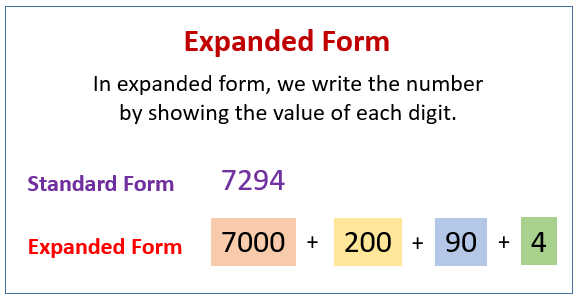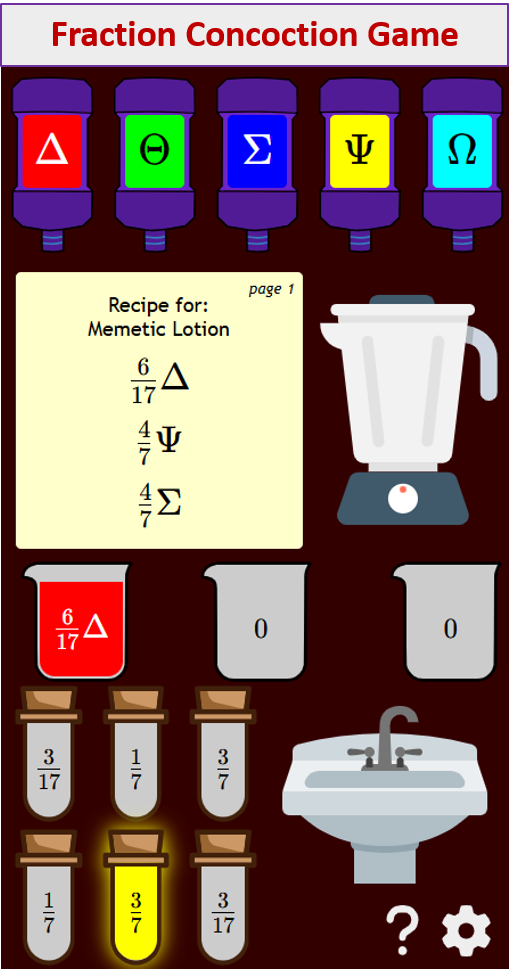Expanded Form
Related Pages
Numbers In Expanded Form
More Lessons for Grade 3
Math Worksheets
These lessons, with videos, examples, and solutions, teach Grade 3 students how to write numbers in expanded form.
What is Expanded Form?
Expanded form is a way of representing a number as the sum of its place value components. Writing a number in expanded form shows the value of each digit.
The following diagram shows how to write a number in expanded form. Scroll down the page for more examples and solutions.

-
Printable & Online Place Value Worksheets
Printable & Online
Ten and Ones (eg. 17 = __ ten and __ ones)
Count Tens & Ones (with pictures)
Count Tens & Ones (with place value charts)
Tens and Ones (eg. 73 = __ tens and __ ones)Add Tens & Ones (with pictures)
Add Tens & Ones (eg. 60 + 4 = )
1 more, 1 less, 10 more, 10 lessHundreds, Tens, Ones (eg. 536 = 500 + 30 + 6)
Expanded Form (up to hundreds)
Expanded Form (up to millions)
Expanded Form Worksheet
How Expanded Form Works
Every digit in a number has a specific “place value.” When we write a number in expanded form, we write out the value that each digit represents and add them together.
Here’s an example of a number expressed in expanded form:
Example:
Write 536 in expanded form:
536 = 500 + 30 + 6
In this example, the number 536 is expressed as the sum of its place value components: 500 (in the hundreds place), 30 (in the tens place), and 6 (in the units place).
Let’s try another example:
Example:
Write 9,845 in expanded form:
9,845 = 9,000 + 800 + 40 + 5
In this example, the number 9,845 is expressed as the sum of its place value components: 9,000 (in the thousands place), 800 (in the hundreds place), 40 (in the tens place), and 5 (in the units place).
Expanded Notation: How can I write numbers in expanded form?
Write the following in expanded form:
- 598
- 9,507
- 75,080
- 900,862
- 9,604,008
- 28,070,501
Standard Form, Expanded Form, and Word Form of Numbers
Learn to write numbers in standard, expanded, and word form.
Here are the definitions and examples of standard form, expanded form, and word form of numbers:
Standard Form: Standard form, also known as normal form or standard notation, is the conventional way of writing a number using digits. In standard form, a number is written with digits and follows the usual rules of place value, where each digit represents a specific place value in the number.
Example:
Standard Form: 345,678
Expanded Form: Expanded form is a way of writing a number as the sum of its place values. It breaks down a number into its individual digits and shows the value of each digit based on its place value.
Example:
Expanded Form: 300,000 + 40,000 + 5,000 + 600 + 70 + 8
Word Form: Word form is a way of writing a number using words. It represents the number using words for each digit, following the rules of place value.
Example:
Word Form: Three hundred forty-five thousand six hundred seventy-eight
Expanded Form helps you understand:
- Place Value: What each digit in a number actually means based on its position (ones, tens, hundreds, thousands, tenths, hundredths, etc.).
- Number Sense: How numbers are built up from different parts.
- Addition: It connects directly to how we add values together.
Variations of Expanded Form
Sometimes, you’ll see expanded form written using multiplication or powers of 10, especially in slightly higher grades:
Using Multiplication:
235=(2×100)+(3×10)+(5×1)
3.14=(3×1)+(1×0.1)+(4×0.01)
Using Powers of 10:
235=(2×102)+(3×101)+(5×100)
3.14=(3×100)+(1×10-1)+(4×10-2)
Try out our new and fun Fraction Concoction Game.
Add and subtract fractions to make exciting fraction concoctions following a recipe. There are four levels of difficulty: Easy, medium, hard and insane. Practice the basics of fraction addition and subtraction or challenge yourself with the insane level.

We welcome your feedback, comments and questions about this site or page. Please submit your feedback or enquiries via our Feedback page.